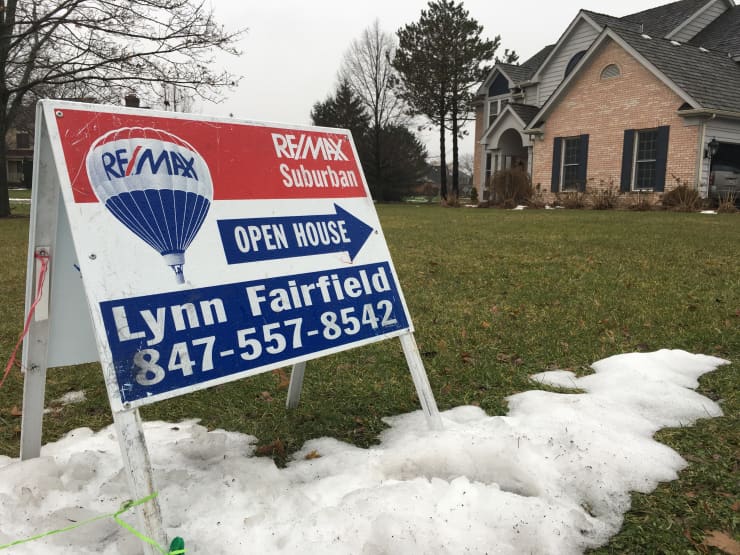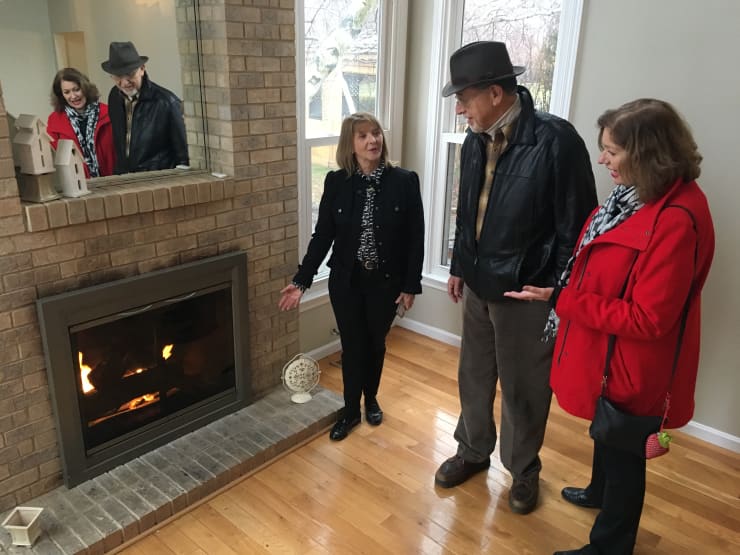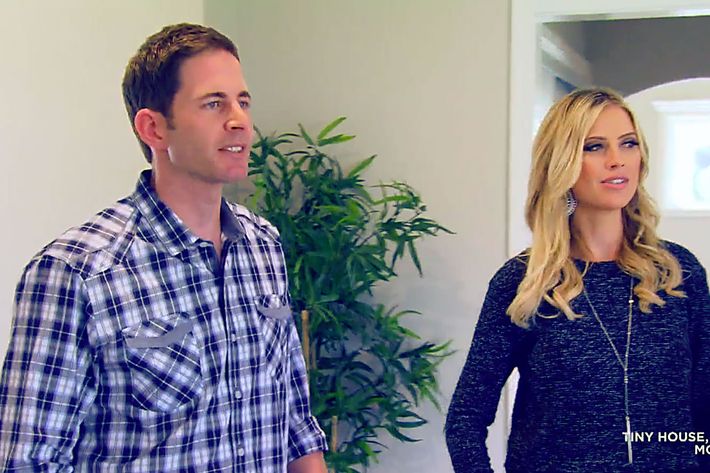A man in the desert touches flame to a snaking trail of gasoline, and as fire whips across a blasted stretch of earth, coming dangerously close to his parked monster truck, he leans back, extends his open arms to the sky, and calls out, “I am all that is man!”
Moments earlier, we have seen a dead cockroach lying boots up on a patch of white carpet, provoking the high-pitched screech of a woman.
Who are these gendered stereotypes of yesteryear, the muscle-bound dumdum and the easily terrified screamer? They are Man and Woman, irreducible and impervious to the political or sexual fashions of an era. Or, as HGTV calls the two halves of the binary: They are General Contractor and Designer, and this particular pair have come to Las Vegas to make a quick buck by flipping foreclosures.
Bristol and Aubrey Marunde are the stars of Flip or Flop Vegas, and they have brought the HGTV formula — an endless loop of television in which the dreams of women are made manifest by the swinging sledgehammers of men — to the quivering edge of reductio ad absurdum. They love one another; they never quarrel; they worship together at the Church of Home Depot in the Parish of Lowe’s.
HGTV was the third-most-popular network on cable television in 2016, a 24/7 testament to the powers of Target chic, the open-plan kitchen, and social conservatism. It unspools with the same bland cheerfulness as Leave It to Beaver, and its heart is in the same place. Many viewers — in red states and blue cities, in rent-controlled studio apartments and 6,000-square-foot McMansions — confess it’s a bedtime ritual, prelude to a night spent dreaming of ceramic-tile backsplashes and double-sink vanities. Over the past two years, it has become such a ratings and advertising sensation that it is largely responsible for the recent sale, this summer, of its parent company, Scripps Networks Interactive, to Discovery Communications for $11.9 billion.
The Best of Chip Gaines Not Working
HGTV depends on the dream that has been with us since the saltboxes of New England and the Spanish bungalows of Southern California and the Leisuramas of Montauk: that if you can just get the right house — the one that looks like your friends’ houses look, only a little bit better — your family will pour into it, like thick cream into a pitcher: smooth, fluid, pleasing. Who could get a divorce in a house with so many lush towels rolled up in the master bathroom? Who could raise a sullen teen when there is a “great room” where the family can gather for nachos and football on the big screen?
We are supposed to be in rehab from our housing binge of ten years ago, the one that nearly bankrupted the country. We are supposed to be in a state of contrition. But our national love of HGTV suggests that the dream won’t die. The longing it addresses is impervious to market corrections, or personal financial realities, and as economists continue to explore the true causes of the 2008 financial crisis, they are beginning to suspect that some speculative Americans acting on that longing got us into that mess as much as — or more than — unscrupulous bankers or Wall Street. In fact, the network may now be tempting its millions of fans to dip their toes back into the most dangerous waters of the past crisis: flipping.
HGTV came on the air in 1994, not to the trumpet blast of self-confidence associated with a future billion-dollar brand but to a little kazoo squeak of uncertainty. The shows were homey, centered on thrift, and they often starred regional celebrities making crafts or minor house repairs. A nice lady from Minnesota taught viewers how to decorate cheaply on Decorating Cents. (Why not spray-paint some silk flowers and then glue-gun them to your bathroom wall?) The hosts of Room by Room might invite their friend Bob — “from Bob and Pete’s Floors” — to explain how to choose something affordable and attractive for the kitchen floor.
But it was in 1999 that the network found its audience with a new show called House Hunters, of which there are now an astounding 1,772 episodes. This wasn’t about people dicking around with their bathrooms or dithering over a few feet of floor tile. This was about going all the way. This was about buying a house. The first few seasons were heavily influenced by hit shows on another network, TLC, where A Wedding Story and A Baby Story had found a large audience, composed mostly of young women, who were eager to watch 30-minute documentaries about couples making huge steps in their lives. HGTV beat them to the punch with a show about the next step in a dream couple’s life.
The early episodes are very different from what the show has become; they were full of the pitfalls of buying a house for the first time. One couple had to delay the process for a year so that they could improve their credit; they each cashed out money from their retirement funds. The husband said, “It’s a scary decision. It’s the most expensive thing and the biggest purchase we’re gonna make.” (As viewers later learned about the series, all of this was a re-creation — you can’t be on the show unless you’ve already closed on a house — but no one’s looking for the Meisner technique on reality television, and they sold it well enough.)
The houses in the couple’s price range were strewn with the evidence of human occupation and other bits of nastiness. “That could be a pet stain,” the real-estate agent says nonjudgmentally as the couple look glumly at a spot on the dining-room floor, “or coulda been a plant there.” A house with a small kitchen and battered cupboards is out, the host tells us, because “money is tight, and this family would rather prefer to put all of their money toward a down payment instead of renovation.” It was like what buying a house is really like, but it was also kind of a bummer. On A Wedding Story, you got a beautiful dress and a church full of flowers; on House Hunters, you got pet stains and problems with your credit. Soon enough, that all changed.
Today, House Hunters, like all HGTV shows, follows a formula as inflexible as the Latin Mass. You meet the buyers (usually a couple), learn where they live and what their budget is, and watch as they describe marriage-busting differences of opinion in a way that makes them look like they’re choosing what to watch on Netflix. He’s the breadwinner who wants to live close to work; she’s an at-home mom who wants to live in a far-off suburb. She’s a spender; he’s a saver. What they need is a post-nup; what they get is an expensive house an hour from his job, because HGTV women tend to win these quarrels, although he will usually get some concession — a north-facing patio so he won’t sweat like a dog when he’s out grilling; a three-car garage. By the time we bid them farewell, they’re in the great room, sipping white wine from giant, reality-TV wineglasses and purring like kittens.
The show has many spinoffs, such as House Hunters International, which ought to be named “God Bless the USA.” On an episode called “Oh No Okinawa” an American military couple who want a big kitchen and a view of the ocean get neither, while their crestfallen teenage son looks at his small Japanese bedroom and talks wistfully about missing his senior year back home. There’s Tiny House Hunters (about tiny houses, not tiny hunters), Beachfront Bargain Hunt, Lakefront Bargain Hunt, House Hunters Off the Grid — for when HGTV finds a successful show, it turns it into a genre and the audience happily follows along. The shows don’t really have hosts; there’s a narrator and sometimes a real-estate agent — but for the most part it’s the buyers and the houses who are the stars.
But just as the mild stimulant of Decorating Cents made way for the Adderall of House Hunters, so did the latter prepare viewer and network for the speedball of flipping, which is now the core of the network’s most successful shows and which may be the most dangerous part of a national obsession that has caused us all great grief in the past and possibly even spurred that global financial crisis. It all began with Property Brothers.
Jonathan and Drew Scott are a pair of metrosexual, gaga-handsome, Canadian identical-twin brothers whose early quests for fame were unsuccessful, perhaps owing to the decline of evil-twin narratives in daytime television. They had both wanted to be actors, but no luck. Drew spent $100,000 trying to break into the acting world. Jonathan wanted to be a magician with a big, David Copperfield type of show until someone stole all his props and he had to file for bankruptcy. In 2004, they opened a real-estate-services company — Jonathan had become a general contractor and Drew a real-estate broker — to support them in their pursuits. While the company was successful, the entertainment thing never panned out. And then, as in one of those career seminars in which you are encouraged to write down all of your strengths and combine them into one ideal job, the break: They would use their skills choosing and renovating houses and their cheerful, hammy acting abilities to star in a reality-television show. It was an immediate hit and has had several iterations, but it has now settled on a format: The twins show the buyers the house of their dreams and then tell them it’s way over their budget. They persuade them to choose a so-so house, and then Drew — whose work consists merely of a day driving the buyers to properties — lounges around in his flat-front trousers and skinny ties making such catty comments about his brother’s grunty physical labor that they seem more like a couple than twins.
On a recent episode, all of the players delivered their lines with dinner-theater enthusiasm. A fed-up working mom looked up from her cramped home office — really just a corner of the dining-room table — and demanded, “We need the brothers to find our dream home now.”
Her husband, an at-home parent and susceptible to the whims that can accompany that calling, announces that he wants “all top-of-the-line appliances.”
The twins tell the couple that they can’t afford what they really want, and the couple pretend to freak out. They say they’re uncomfortable about having to make renovations, so Drew scares them with fancy talk about finance. “What’s worse: getting your hands dirty with a fixer-upper or having to overleverage and get tied up in a mortgage for a hundred years?”
With the thought of a century of mortgage payments to motivate them, the couple go for the renovation. Anyone who has watched HGTV for more than a week knows what this will involve, because all of the makeovers on all of the shows are the same: blow out the walls around the kitchen so you can see the big screen from the center island; put some large furniture in the living room so that it looks grand; install hardwood floors or laminate that looks like hardwood; dress up the bathrooms with ceramic tile and walk-in showers; run some sod in the backyard and add some plants; and then quickly film the whole thing before the blossoms fall off $800 worth of annuals. The couple and their two sons love it.
The Property Brothers don’t flip houses; they remodel for individual clients. But viewers found that they loved watching the process of a butt-ugly house getting transformed into an open-plan showplace. Soon, a new HGTV genre was born: shows about married couples (he’s a contractor, she’s a designer) who buy and flip houses together. A golden formula was at hand. Created to compete with A Wedding Story and A Baby Story, HGTV has always had its roots in a quiet social conservatism, a world where houses are containers for families and where the center of a family is a marriage. Moreover, it cannot be denied that the recent HGTV parody on South Park had an apt title: “White People Renovating Houses.” Once the network started putting a married couple with star power on a show — and featuring not just the houses they were flipping but also their own homes and their children and happy moments from their daily lives — it jump-started the ratings streak that has made it so successful.
The upswing began with Christina and Tarek El Moussa, stars of Flip or Flop. A pair of blandly good-looking Orange County real-estate agents, they had taken a bath during the Great Recession and had to downsize from a McMansion to a small apartment. After the housing bust, Orange County had one of the highest numbers of foreclosures in the country, which made life as a broker there especially grim. But a few years passed, and that huge inventory of abandoned, slightly outdated houses began to present a business opportunity. The couple decided to become speculators, buying some of the houses on the cheap, tarting them up (the same open-plan kitchen/luxurious bathrooms as The Property Brothers, but with an OC bent: cheap surfaces that look polished and high-end).
Tarek is often concerned about a property’s condition, but Christina knows what to do. She was born and raised in the OC and understands what buyers want. She’ll praise a small Anaheim bungalow for being “mid-century modern” (the new real-estate term for every rattrap built after 1945) and then dress it up with cheap chandeliers, marble floors, shiny white cabinets, and stark color schemes in the black-white-silver palette. With her French manicure, straight-ironed blonde hair, amazing figure, and willingness to make cutting remarks, she was born for reality television. Tarek’s job is to keep the workmen on task; as with all of the host husbands, he’s a bit of a supernumerary to much of the process, which is the problem with the supposedly traditional unions the network promotes: The women tend to be much smarter and more powerful than the men.
The couple soon became aspirational-lifestyle celebrities, and their marriage and family life were regularly featured in People magazine and on morning television. Yet while Christina seemed to become more confident on each episode, Tarek often appeared wan and anxious. In 2013, a viewer wrote that a lump on his neck looked suspicious, and it turned out to be thyroid cancer. A month after beginning treatment, he learned he also had testicular cancer. He had to get surgery for “multiple herniated discs” in the middle of filming an episode in which he had winced in pain every time he’d tried to lift something; sitting in an orthopedic chair, he called Christina to praise her for handling everything on her own — but she clearly had it all under control. Last fall, the world learned that their off-camera home life was a bit of a flop. After months of secret trouble, police rushed to their place after receiving a call about a “possibly suicidal male with a gun.” Tarek had run to the hiking trails near their house with a loaded gun, and it took 11 cops and a helicopter to locate him, and get him to drop the weapon. He’s since been linked in the tabloids to their former nanny.
The couple are divorcing. They are, amazingly enough, also continuing to film a new season, but viewers who love the show have plenty of other married flippers to fall in love with: There are now Flip or Flops set in Atlanta, Fort Worth, and Chicago.
But if you want a stable, heartfelt married couple to fix your dreams to, the place to look is far away from any of these big cities. You need to go to Waco, Texas, where Joanna and Chip Gaines — stars of Fixer Upper — are creating not just a hit show but a home-remodeling empire of their own.
To call Chip and Joanna Gaines telegenic is an understatement. He’s a sunny, redheaded country boy who evinces no interest in fancy learnin’ but has a heart of gold. On one episode, he divided his time between remodeling a house and preparing for his flight on an F-16; the Air Force had chosen him as one of its Hometown Heroes, “ ’cause I renovated a bunch of houses for some families who were really, you know, in need of a pick-me-up at that time in their lives.” The subtitle of his upcoming business book, Capital Gaines, is “Smart Things I Learned Doing Stupid Stuff.” She is his devoted opposite: thoughtful, artistic, and sensitive to beauty. She has long black hair, an oval face, and an olive complexion, facts that — combined with her Texan accent and affinity for the land — lead many viewers to assume that she is Native American and that theirs is some sort of Ur-Texan pairing. In fact, she is half-Korean and a quarter Lebanese. They are Evangelical Christians, and she has spoken often about the importance of their marriage and the central role Chip plays in her life. That said, he is something of a Lucy to her Ricky, and — like all HGTV wives — you can see her biting her lip in quiet frustration when she’s trying to get important work done and he’s yukking it up.
On Fixer Upper, Chip and Joanna help home buyers on limited budgets get the most out of their investments by choosing “the worst house in the best neighborhood.” That’s an old real-estate canard that has long been dismissed, but no matter — when Joanna starts describing all the wonderful things she can do to it, thoughts about resale value melt away into dreams of sliding barn doors, over-tufted sofas, and newly built “mud rooms” where the kids can stash their backpacks and soccer gear. Once the buyers have chosen their new house, they’re whisked away and the work begins.
It is as though Chip has spent all of Act One in a quivering agony of self-control, but at last he is free. He grabs a sledgehammer and, with Joanna’s permission, starts bashing away at the first wall she has marked for destruction. SLAM! CRASH! BANG! Chip is finally in concert with his true nature. This banging away at walls is the centerpiece of every HGTV show that involves renovation — as do all of its most popular programs — and there is something profoundly satisfying about it, even though it’s a preposterous way to go about the task. Taking out a single wall when you want to leave the rest of a room intact involves carefully cutting the drywall, teasing it off, and then taking down the framing behind it. But the reckless bashing makes for good television, and it dramatizes the signal design imperative of HGTV: Whether you live in Burbank or Barcelona, you absolutely must have an open kitchen.
While Chip knocks down the walls, Joanna paints the new rooms in a pleasing light color, usually in a sophisticated palette that is based on a combination of gray and beige sometimes called “greige.” Her style owes much to the muted good taste that Martha Stewart made available to the masses. Martha is generous about the long reach of her shadow, although this summer she sent out a credit-taking tweet: “I cannot believe that ‘greige’ is trending as a paint color! All my homes are based on grey/beige.”
Joanna has beautiful white cabinets installed in the kitchen and recessed lighting that illuminates them like saints in their niches. There will be miles of countertops and dark-wood floors for a contrast to all the white. Sometime during the process, the Gaineses’ carpenter friend Clint may show up to get a brief on some wood feature Joanna has designed, and he will cheerfully trot off to execute her desires. Often the cameras give us quick glimpses of workmen who labor away under Chip’s direction, all of these men — laborers, artisans, foreman, husband — making manifest a woman’s exacting vision.
The night before the reveal, Joanna is in a swivet of type-A concentration. She has brought beautiful flowers wrapped in brown paper and tied with raffia, and she arranges them in a loose bouquet; she sets the table with pretty napkins and plates; she rolls hand towels and puts them in a basket in the guest bath. And then the new owners arrive.
They swoon, they moan, they marvel. They are like game-show winners, and their gratitude to Chip and Joanna makes it seem like the Gaineses are their generous benefactors, not — if the premise of the show is to be believed — tradespeople whom they have paid to do a job. Nothing makes the buyers lose their composure like the kitchen. How beautiful it is, how stunning to see it compared with “before” pictures. Nothing bad could happen to a family who has a kitchen like that. It’s too pretty, too calming, too clean. It’s too full of Chip and Joanna’s radiant good cheer and their careful understanding of what each family most wants: “You had said you wanted a place for Caleb to do his homework while you’re making dinner — so we’ve built in this desk next to the island.”
Caleb’s not going to do his homework at that stupid desk; on some level, we all know that. But the dream of a boy sitting happily in his mother’s kitchen, filling out his worksheets while she sips a big bubble glass of chilled Chardonnay and cooks — what? Quickie quesadillas? Three-step lasagna? — In her fantastically overbuilt kitchen is a powerful one, and for a few happy Act Three minutes, we dream that little dream, too.
The first thing counselors tell sex addicts is to stop watching porn, and we really shouldn’t be watching this much HGTV during our rehab. Although it’s a soothing experience, it is also a fomenter of deep feelings of discontent about one’s living arrangements, which began to hit me hard around week two. Why have I allowed my attic “bonus room” to remain covered in the exact type of wall-to-wall carpet that repulses Joanna Gaines, Christina El Moussa, and both Property Brothers? And what failure of character is revealed by my closed-plan kitchen? HGTV makes big, expensive, time-consuming remodels look like two weeks’ work and a modest amount of money well spent. Moreover, it links these changes so definitively to personal and family happiness that you begin to wonder what, exactly, is wrong with you that you haven’t made some of them. The discontent gnaws as the addiction to the programming grows, and you have to imagine many viewers find themselves enticed to do foolish things like take out second mortgages so that they can blast out a few walls and get a little of what Chip and Joanna seem to have. More troublingly, we also have to wonder how many may be inspired to think that they, too, have what it takes to flip houses.
A recent, worrisome working paper released by the National Bureau of Economic Research reported on the tinder of the last conflagration: the national sense that housing prices were going up every day and that there was no way that a buyer’s reach could exceed his grasp. It’s true that bankers made loans to Americans wildly unqualified for them — but the notion that buyers on the lower end of credit distribution began to default in unprecedented numbers isn’t accurate. In fact, the rate of default in the subprime market throughout the bubble and the bust remained steady compared with before the crisis. It was buyers from the top and middle top who account for the skyrocketing rate of default — and it wasn’t that they were buying bigger family homes that they couldn’t afford. It was that they were buying additional houses to flip for a profit, and when holding on to them stopped making financial sense, and with no personal and emotional connection to them, they began walking away in huge numbers.
And yet … the flippers on HGTV make it look so simple, so fun. At the end of each episode, they run the numbers and show how much the happy couples have pocketed. What could the network be quietly motivating its viewers to do? With our real-estate-loving president — who has Property Brothers programmed into the TiVo on Air Force One and who is eager to do away with regulations, which are one of the forces supposed to protect us from another bust — we could be in the early stages of another crisis. Our collective fate could be largely in the hands of … Christina and Tarek El Moussa and however many people they inspire to pick up a house at a foreclosure sale. Which is why Flip or Flop Vegas may be the best HGTV show yet, as it unfolds in the place where slots are loose and the casinos never close — the best natural habitat for this kind of programming, and, as it happens, one of the worst-hit areas in the last financial crisis.
Out in the desert heat of Las Vegas, Aubrey and Bristol toil cheerfully away. She has vocal fry, a cute wardrobe, and a real-estate license. He’s not just a general contractor; he’s also an MMA fighter. They bring the HGTV pairing of smart woman–dumb man to the farthest possible reach.
On a representative episode, they arrive at a run-down house they might buy, but they haven’t obtained the lockbox code, so there’s no way to get inside. Bristol suggests kicking in the front door. “No,” Aubrey explains to him patiently, “ ’cause we haven’t bought it.” Then he suggests shimmying under the garage door, which has been left slightly open, but his ass gets stuck. “Give me a little help,” he cries, and she pushes him through. They walk through the house, and she dreams up some plans for it. “How are you gonna fit an island and a dining-room table in this tiny little kitchen? I just don’t see it,” he says. “Watch and learn,” she tells him.
Together they go on to create something I’d never seen before on HGTV: a fantastically ugly house. Before they flipped the property, it was a modest, even attractive Spanish-style tract house with a red-tile roof. Yet it inspired Aubrey to transform it into a style she calls “glam farmhouse.” The very phrase was so marvelous and weird that I championed it immediately and saw in this couple the possibility of breaking down some of the rigid conventions that bind HGTV’s designs. Indeed, the finished house is a tour de force.
The interior is composed of a hideous color scheme: forest green, bright white, and dark brown. The white wood ceilings were “farmhouse,” and the Vegas accents were “glam”: gold and white bedside lamps, an extravagant white shag rug, accent pillows in hot orange and white marabou, a chrome coffee table. “Buyers in Las Vegas are savvy,” Aubrey explains confidently. “They’re very sophisticated.” The living-room credenza is glam, and it’s topped with tall lamps composed of rustic wooden bases (farmhouse), but the shades are industrial mesh. There’s not a moment of wit anywhere, even though the landscape design belongs in a Tim Burton movie. There are fussy topiaries, unpainted cinder-block walls, a set of stepping-stones to nowhere, wide areas covered in red bark nuggets, and one rectangular patch of bright-green lawn. The result of all this work, Aubrey tells us, is a house that’s “super-custom.” The fuzzy, neon Austin Powers pillows make it “feel like a home.”
The actual style is ’70s Porn Shoot. There’s no greige. There’s no homework area. The proportions don’t even work. It turns out — go figure — Bristol was right: To squeeze between the dining-room table and the center island to get out the French door requires gymnastic precision. But Aubrey is a winning character — determined, smart, and able to get materials at a tremendous discount. “I ask to talk to a manager — you don’t ever want to talk to a sales rep — and ask for a discount,” she says. “Tell them about your project. People really want to help, they do.”
read more…
http://www.vulture.com/2017/09/the-ugliness-behind-hgtv-never-ending-fantasy-loop.html?utm_source=digg&utm_medium=email















